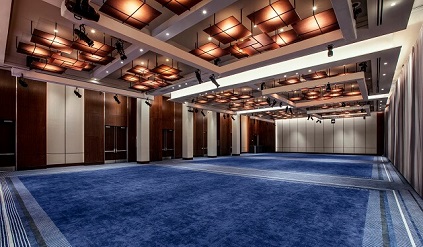NEW YORK—One of Manhattan’s most prominent luxury hotels—the 463 all-suite Conrad New York Downtown—keeps pushing the bar higher for sustainability leadership in the Big Apple. Since opening in 2012, the hotel has maintained its LEED Gold certification, implemented numerous water-, energy- and waste-saving initiatives, and it just recently became the first hotel in the city and one of the first in the U.S. to utilize Power Over Ethernet (PoE) technology. The Sinclair in Fort Worth, Texas also uses this technology.
PoE is used at the Conrad New York Downtown to power LED lighting in the lobby, in the newly renovated meeting space, at elevator landings, and outside the hotel’s ATRIO Wine Bar & Restaurant.

“PoE lighting is a form of smart lighting,” says Chintan Dadhich, General Manager at the property for almost a year. “It gives you financial savings and improves your ability to control the system using a smart phone app. There is an ethernet cable running to every fixture and you run data from each fixture.” The system also provides power to areas that lack electrical outlets.
“It was complex,” Dadhich adds. “The design process took a little more than a year. It involved opening the ceilings, removing wires, and running new cables. It was set up through a third party. I expect to see a 60 to 75 percent savings in lighting energy costs. Where a standard lightbulb takes 120 volts of electricity, PoE lights run on 12 to 24 volts of electricity. When a fixture gives off more electricity it also produces more heat, using more energy to cool the space. It will also reduce maintenance expenses.”
Building-wide Management System
The PoE technology is just one small part of the hotel’s overall conservation efforts. “In guestrooms we have an INNCOM energy management system,” Dadhich says. “It adjusts the HVAC system and the lighting system when guests enter or leave the room. It is linked with our Building Management System which allows the engineering team to control all the mechanical equipment.”
All the mechanical pumps have variable frequency drives. “It allows us to control them better,” Dadhich adds.
A portion of the rooftop operates as a produce garden, providing shade and reducing temperatures of the roof surface and surrounding air.
Waste-Reducing Efforts
To minimize waste, full-sized bath and body amenities are used instead of single-use disposables. All used soap boars are also recycled through Hilton’s partnership with Clean the World. “We also recycle the Nespresso Pods after they have been used in the guestrooms,” Dadhich says.
In 2019, the hotel installed water filtration systems in each suite, eliminating single-use plastic water bottles in guestrooms. All guestrooms have two recyclable aluminum water bottles. Upon request, glass water bottles are available. “We also have two water fountains in high-traffic areas with bottle dispensers, which count how many plastic water bottles are saved by using the fountain,” Dadhich says.
All F&B to-go containers are biodegradable and plastic straws have been eliminated. All banquet events use compostable disposables. Receptacles are color coded. To reduce food waste, portions are monitored very carefully. Three times a day, food waste is taken for composting. One-fourth of all waste is recycled. Reusable non-plastic laundry bags are also in-suite for guest use, key cards are made with recycled paper instead of plastic and the hotel uses Digital Key, which allows guests to access the property and their room via their smartphones.
“We also do not print documents unless the guest requests a printed copy, as we e-mail or text the guest depending on the preferred communication method,” Dadhich says. “This process cuts down on extra wasted paper.”
All Utility Data Reported to Hilton
To conserve water, fixtures are low flow. “All toilets are equipped with dual flush capabilities and showerheads use aeration devices to limit water usage, ensuring reduced waste,” says Dadhich, adding that as part of Hilton, all utility data is entered into LightStay by engineering staff monthly.
While many of the hotel’s vendors are national, local ones are used for F&B as much as possible.
Dadhich says ESG is talked about at every weekly executive committee meeting and the hotel has a goal of one community activity each quarter. “For example, we prepared backpacks and stationery items for underprivileged schools,” he says.
As part of Hilton’s “Meet With Purpose” program, the Conrad New York Downtown offers meeting and event planners with an option for Carbon Neutral Meetings. Using data gathered from the LightStay platform, Hilton has developed the Meeting Impact Calculator report, which uses each property’s unique consumption data to create a custom report detailing the predicted carbon, energy, water, and waste that has been generated by a meeting or event. Hilton will also offset each event’s carbon emissions as identified by the Meeting Impact Calculator report and will invest in a portfolio of high-quality carbon reduction projects with its partner, ClimeCo.
Ambitious Efforts Not Unnoticed
On a personal level, Dadhich says, “The subject of sustainability is near and dear to me.” At the hotel level, green efforts have not gone unnoticed. “Hilton brought its top 100 customers from around the world, and they were able to experience these initiatives,” Dadhich says.
What Dadhich and his team are doing is helping Hilton reach its 2030 Travel with Purpose Goals—goals that were first set in 2018. One of the goals is to cut managed portfolio emissions intensity by 75 percent by 2030. Click here for more details.
Glenn Hasek can be reached at greenlodgingnews@gmail.com.






